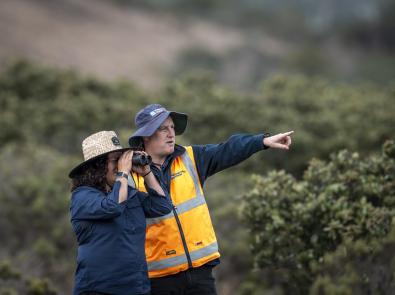The Western Port Ramsar site spans nearly 60,000 hectares of wetlands, tidal flats, and seagrass meadows. It is internationally recognised for its biodiversity, rich birdlife, and its role in supporting healthy marine and coastal ecosystems.
These wetlands filter water, support fisheries, reduce flood risk, and provide habitat for thousands of native species.
We acknowledge that these wetlands sustain the Bunurong people of the Kulin Nation and their way of life. We acknowledge that this land is the place of age-old ceremonies and custodianship, and that the Bunurong peoples’ living culture continues to have a unique role in the life of this region. We pay our respects to their Elders past and present.
Why Western Port matters
All Ramsar-listed wetlands have an Ecological Character Description (ECD). The ECD describes all the natural features that makes the site important and unique - the plants, animals, water systems, and landscape features that support life there. It also explains how these parts work together, and why the wetland matters locally, nationally, and globally. The ECD helps us understand what needs to be protected so that the wetland keeps its special ecological values.
Western Port Bay is one of just 12 Ramsar wetlands in Victoria - and its ecological character is what earned it a place on the international Ramsar list. Its ECD shows that Western Port is a rich and complex system that supports an amazing variety of life. Here’s what makes it special:
- Vital stopover for migratory birds: Each year, birds from as far away as Siberia and Alaska travel thousands of kilometres to feed and rest on Western Port’s mudflats and saltmarshes. Some are threatened species that rely on this site to survive their journey.
- Extensive intertidal mudflats and seagrass meadows: These areas are teeming with tiny creatures that feed fish and birds, supporting the whole food web.
- Rare coastal habitats: Western Port has the southernmost mangroves in the world, along with saltmarshes and sheltered estuaries that help store carbon, reduce erosion, and support marine life.
- A diverse and dynamic estuary: The mixing of freshwater from rivers with salty seawater creates the perfect conditions for biodiversity, with over 1,350 species recorded in the region.
Challenges Western Port Ramsar is facing
Western Port faces growing pressure from urban development, habitat loss, invasive species and climate change all threaten the ecological values that make this place special. That’s why at Melbourne Water we are working closely with Traditional Owners, local councils, conservation groups, Landcare, tourism operators and other government agencies to balance progress with protection and to ensure the ecological values of this wetland are front and centre of every decision that affects it.
Melbourne Water is the official site coordinator for the Western Port Ramsar site. That means that through science, collaboration, and investment in wetland health, we’re working in partnership to ensure Western Port remains a thriving natural environment.
What we’re doing
Our work includes:
- Long-term ecological monitoring
- Seagrass restoration and invasive species control
- Working with landholders to support wetland management on private property
- Supporting cultural knowledge-sharing and partnerships with Traditional Owners
- Planning for the impacts of climate change
Current projects
Restoring Western Port: This multi-year project, funded through the Victorian Government’s Healthy Waterways Strategy, supports seagrass restoration, Spartina weed control, and habitat improvement for key species.





